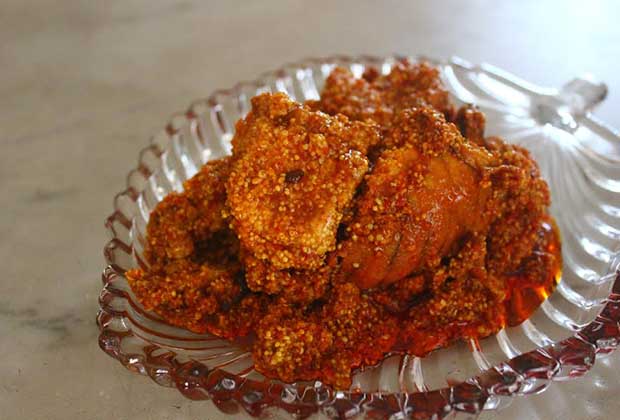Your Definitive Guide To Parsi Pickles - I
- By Anjali KoliLoading...
- | 16 Dec 2016 7:38 AM GMT
 X
X
 Gharab nu achar or fish roe pickle. Photo: Anjali Koli
Gharab nu achar or fish roe pickle. Photo: Anjali Koli
I was introduced to Lagan nu achaar on a Navroze day many decades ago. I was in school then. I still remember I had a passionate discussion about it with the friend who introduced it to me. With the flick of my finger I picked it up from a tiny single serve jar she had brought it in, and a close look told me it was not an achaar but a chutney.
But then, Bawas do everything differently. They call it Lagan nu achaar. Their achaars are mostly made with cane sugar and mustard oil or may be a neutral oil in the modern day. If compromised on these, the taste is not the same. For a community that learnt to eat pickles after landing in India, they have created a lovely variety of achaars of their own.
How it started
Pickle derived from pekel in Dutch meaning brine. Pickles are the oldest form of preservation man has known dating back to 4,000 years. History says pickling began with preserving in brine. It was the Indian cucumbers that were preserved first. Vegetables, meat and fish have been preserved when in season and a plenty to be enjoyed through the year.
 Methia nu achar or mango and fenugreek pickle. Photo: Anjali Koli
Methia nu achar or mango and fenugreek pickle. Photo: Anjali Koli
The Bawi pickling process
In the older generations pickle making was a joint effort by groups of women in communities. Typically the afternoon post the day's cooking was done, women gathered together to pickle. The duties would be assigned based on expertise.
Few women would chop up the vegetables or fruits or the fish or meat. These would be the juniors, unmarried girls or the inexperienced daughter-in-laws. One Bawi would huddle over the fire to toast the spices, a couple of women mostly the slightly seasoned and strong women would hand pound the toasted and cooled spices. Some master pickler would mix together the spices and veggies or fruits or something non-vegetarian and fill up barnis depending on the pickle they set out to make.
The labour of love would be left for sunning under the hawk-eyed supervision of the senior matronly Bawi who would be relaxing on an aram kursi and the Bawa on his Bombay Fornicator with a cane kept handy on the long arm to shoo away the greedy kids from dipping their fingers in those jars.
 Tarapori patio or a dried Bombay duck pickle. Photo: Anjali Koli
Tarapori patio or a dried Bombay duck pickle. Photo: Anjali Koli
Introducing the 'Queen' of Parsi pickles
Zinobia Schroff is the queen pickle maker in the Parsi community. Here is a chat I had with her at her home in between filling pouches of pickles to be shipped to the isle in the Atlantic ocean.
Zinobia started pickling in her early teens, her first was Pani nu achaar. She defied the curse of the periods by making the achar and shocking her mother. It did not spoil then and never has until now she says, touching the wooden chair quickly. I guffaw at her busting one superstition and yet being superstitious about her pickling skills!
Growing up in India's orange orchard, Nagpur meant having abundance of the citrus. They would guzzle juice instead of water, she reminisces. She made squashes and marmalades, jams and murabbas selling them to earn her pocket money. A fashion designer in the past life working for the big names, she has been showcased at the Pret a pourte' in Paris. Her true passion though was food she was to realise soon.
Zinobia started catering. Parsi, Bengali and Christians NRIs on their way back to far off lands always pick up her pickles. There are two or three types of Parsi pickles based on the medium used for preservation, Pani nu achaar or brine, vinegar and oil, most Parsi pickles are made in oil.
Wise words she shares, "Never compromise on quality and hygiene, while pickling or cooking have total focus."
Her favourite pickle to make is Lagan nu achaar for its universal taste, it is appreciated by vegetarians and non-vegetarians alike. The degree of chili may vary, but loved worldwide.
Come back to read the second part of the series tomorrow...




